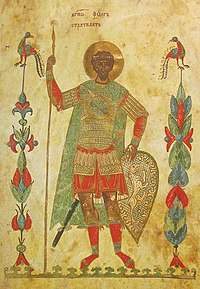Theodore Stratelates
| Theodore Stratelates | |
|---|---|

|
|
| Great Martyr | |
| Born | ? unknown |
| Died | 319 Heraclea Pontica |
| Venerated in |
Eastern Orthodox Church Roman Catholic Church |
| Feast | 8 February, formerly 7 February in the Latin Rite but not now liturgically celebrated in the western church |
| Attributes | Dressed as a warrior , with spear and shield, or as a civilian |
| Patronage | soldiers |
Theodore Stratelates (in Greek, Στρατηλάτης, translated as ("the General" or "Military Commander"), also known as Theodore of Heraclea) is a martyr and Warrior Saint venerated with the title Great-martyr in the Eastern Orthodox Church, Eastern Catholic and Roman Catholic Churches.
There is much confusion between him and St. Theodore of Amasea and they were in fact probably the same person, whose legends later diverged into two separate traditions.
Theodore came from the city of Euchaita in Asia Minor. He killed a giant serpent living on a precipice in the outskirts of Euchaita. The serpent had terrored the countryside. Theodore armed himself with a sword and vanquished it. According to some of the legends, because of his bravery, Theodore was appointed military-commander (stratelates) in the city of Heraclea Pontica, during the time the emperor Licinius (307–324) began a fierce persecution of Christians. Theodore himself invited Licinius to Heraclea, having promised to offer a sacrifice to the pagan gods. He requested that all the gold and silver statues of the gods which they had in Heraclea be gathered up at his house. Theodore then smashed them into pieces which he then distributed to the poor.
Theodore was arrested and subjected to torture and crucified. His servant Varos (also venerated as a saint), witnessed this and recorded it. In the morning the imperial soldiers found him alive and unharmed. Not wanting to flee a martyr's death, Theodore voluntarily gave himself over again into the hands of Licinius, and was beheaded by the sword. This occurred on 8 February 319, on a Saturday, at the third hour of the day. His "lives" are loisted in Bibliotecha Hagiographica Graeca 1750-1754
Numerous conflicting legends grew up about the life and martyrdom of St Theodore of Amasea so that, in order to bring some consistency into the stories, it seems to have been assumed that there were two different saints, St Theodore Tiron of Amasea and St Theodore Stratelates of Heraclea. The earliest text referring to the two saints is the Laudatio of Niketas David of Paphlagonia in the 9th century. It was said that his Christianity led to many conversions in the Roman army, which was the reason that Licinius was so concerned. Christopher Walter treats at length of the relationship between these saints.
...
Wikipedia
